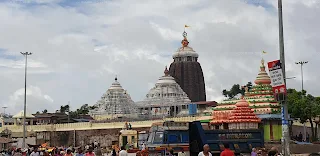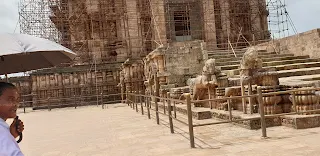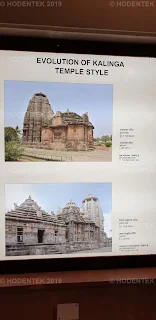September 27, 2019
Summary:
We plan to stop at Shri Jagannath Swamy’s temple to look in the daytime as we had only a hurried visit last night. After that, we will visit the famous Sun Temple at Konark. On our way back to the hotel, we will stop at the famous Ramachandi temple.
Visiting the Shri Jagannath
Swamy’s temple:
We had an excellent
breakfast of Idly, Chutney, Sambhar, and Dosa at the hotel and left the hotel around
10:00 a.m. My sister Usha needed to go to ICICI bank. We stopped for a while
near the bank in the town.
As Michiko had not seen the Shri
Jagannath Swamy’s temple. We decided to go there first. As we could not go near the temple precincts we had to go by Jinrikisha (a carriage drawn by a
person, mostly male). We took a couple of pictures with the temple complex in
the background. Our driver parked his car somewhere and we could only
communicate with him by phone. The crowd is truly incredible. If the crowd on a
non-descript day is like this, I can imagine how it will be on a special day
in Puri which occurs once in 12 years. It truly deserves the name “Juggernaut.”
Although thousands of people, pilgrims, and tourists visit the Puri Jagannath temple, businesses do not care to maintain their establishments in good shape. It is a pity that you see sign boards like the above. This feature is almost common among most of the places that I have visited, no matter North or South. I often wonder when this will change. The city should take some responsibility.
It was a bright day and hard
to open your eyes.
On the way to the Sun Temple
at Konark:
We then left for KONARK
where the Sun Temple is situated. It was still raining heavily. We stopped for
coffee at a wayside inn. They only had tea prepared already with sugar (a
normal practice in India). They do take sugar seriously, beware! It is not tea with
sugar, it is sugar with tea!
Driving in India while crazy
is rewarding as you get to see the countryside. I prefer to show these pictures
since the tourist might see only nice pictures like on the tourists’ posters.
The reality is often jarring sometimes. You often find the most sublime
alongside the profane. I hope if someone wants to know how it was in 2019,
here are the pictures.
Sun temple at Konark:
We reached there around midday as seen by the shadow clock in the temple. A government guide who is a descendant of the sculptors who built the temple met us at the entrance.
Walking around the temple complex
I was fascinated by the friezes with motifs from animals, plants, dancers, and musicians. The intricacy of the sculpture in stone was so meticulous and detailed that it defies description. I could not stop taking pictures and going around the complex.
Friezes of dancing girls around the Nata Mandir
Jaganmohana (Assembly hall), Sun Temple
Sun temple’s Jaganmohana (Jaganmohana in Odia, ଜଗନାମୋହନ)
The temple originally consisted of a Shikara and the Jaganmohana was an assembly hall). The Islamic invaders destroyed the Shikara. However, parts of the Shikara remain in the neighborhood. The softness of the stone has contributed to the loss of resolution in many of the sculptures. It will be nice if someone could take 3-D digitization to keep a record of how it stands now.
Picture source: Shikara with Jaganmohana
Slightly away from the Jaganmohana to the
East is the Nata Mandir (the dance hall) as seen in the picture from the
source: www.101.Bhubaneshwar.com
The thirteenth-century Sun
temple built by the Eastern Ganga dynasty (1028-1435 A.D.) is awe-inspiring. I
knew something like this existed here but was not prepared for such a spectacle.
The jewelry quality work wrought in stone is simply overwhelming. It hurts me
not to have realized earlier in my life the genius of our people from
such ancient times. How was it conceived? How was it built? Why was it built?
There was a myriad of questions in my mind that I could not answer. Imagine a
chariot magnified many times all built out of stone with the most exquisite of
carvings including the wheels and horses. I felt deeply moved by the attention
paid to the details. Microsoft Windows might boast of several millions of code
lines in its operating system, but the Sun temple has zillions of carvings that
simply defy definition.
Here are some of what our guide called naughty figurines frozen in the act.
The foursome in front of the 'wheel'
The Sun Temple sculptures and the figurines in sandstone do reflect the life and times of that period. People of those times did not shun nudity and sex was not taboo including same-gender relationships. Our government guide called some of the sculptures depicting nudity and sex acts ‘naughty.’ The figurines depict animals, domestic and wild. Elephants and horses, mythical creatures, family scenes, dancers, musicians, courtesans, hunters, and the hunted.
Visiting the museum
After the Sun temple, we went over to see the museum. The museum was clean and well-maintained. The entrance fee of Rs 30 is ridiculously cheap. The entrance to the Sun Temple complex was Rs.40 for Indian citizens and Rs 600 for foreigners. India is rich enough and could do away with this dual pricing.
The museum maintained by the
Archeological Society of India is nice, and the visitors must make it a point
to visit the museum and watch the audio-visuals. The museum provides background information on the architectural details and the evolution of temple architecture in Odisha. For example, one can see here pictures of the more
famous temples in Odisha including the Sun temple and the temples in
Bhubaneswar and surroundings. There is also an audio-visual section where they
screen some of the Sun Temple features. It is also a nice rest area after an
exhausting day of walking around the temple.
The Sun salutations show the Surya Namaskara steps
The deity of
The changing of the idols takes place ahead of the famous
Ratha Yatra (Chariot festival) witnessed by millions of pilgrims. The word ‘Juggernaut’ in English finds its
origin in this Ratha Yatra crowding in Puri.
Pilgrims and tourists can buy art objects or framed pictures
of the divine siblings like the one shown here. They are not expensive.
Visiting the Ramachandi temple:
After leaving the Sun temple we drove southwards and
visited Ramachandi temple. This temple predates the Sun temple at Konark.
Goddess Ramachandi is believed to be the
presiding deity of this temple by some while others think the deity to be the
wife of the Sun God.
This temple staff/vendor totally immersed in his smartphone
Dasha Maha Vidya
refers to the ten manifestations of Mother Goddess Kali. Vidya means, knowledge,
but here the reference is to the Shri Vidya sect. A tantric sect that
traces its origins to the Shakti movement. The next picture from
Wikipedia shows the ten manifestations of the Dasha Maha Vidya.
The temple is also
representative of the Tantric and Vidya sects and the picture above from Wikipedia
shows the Ten Maha Vidyas whose sculpture is shown in the previous picture.
After this, we returned to the hotel and had a light dinner after hearing Modi's speech on the TV about ‘Harmony
and peace’ at UNGA.




























































No comments:
Post a Comment